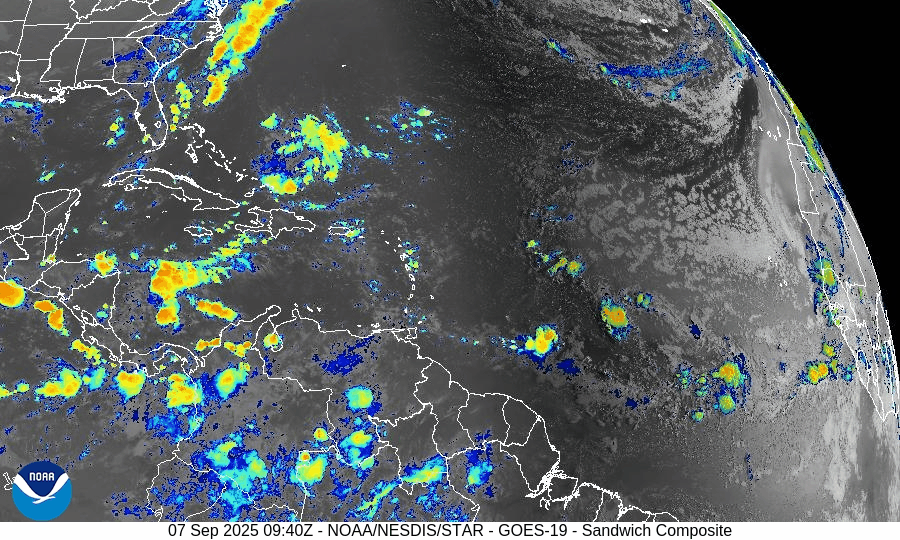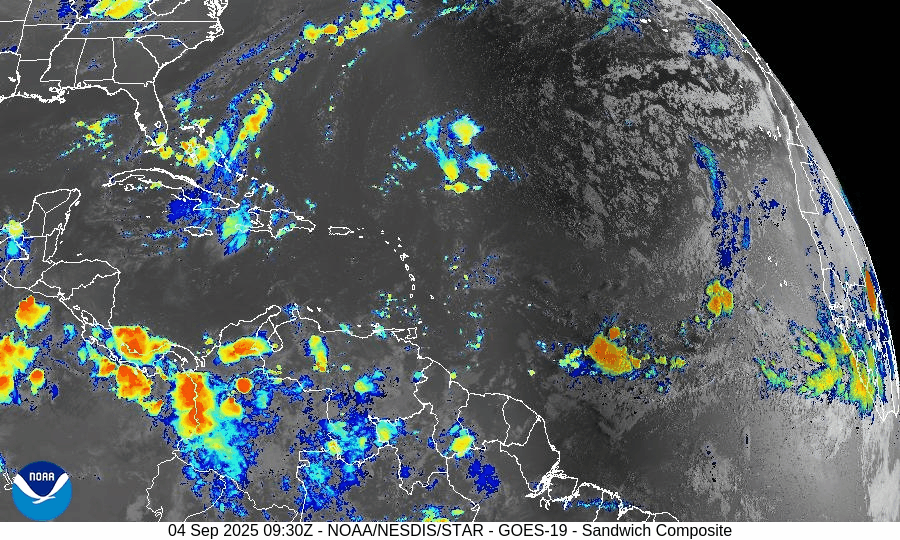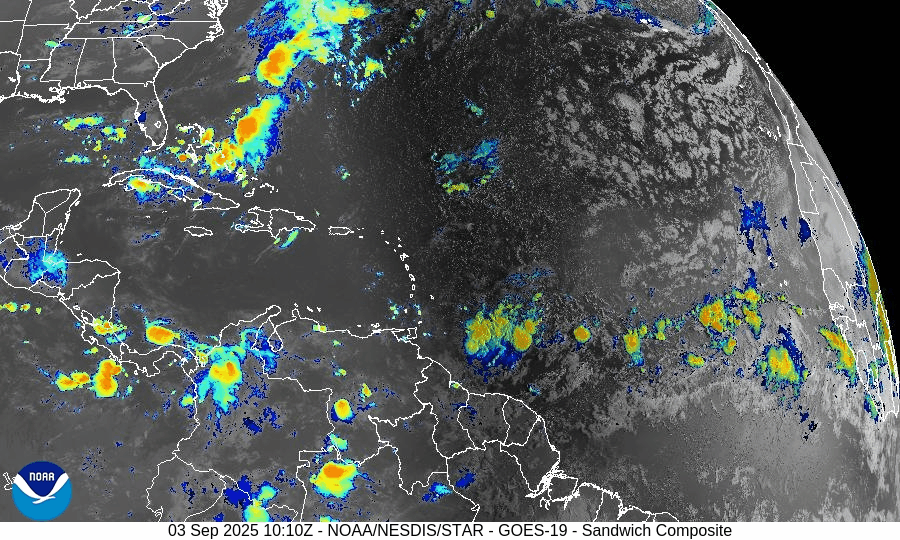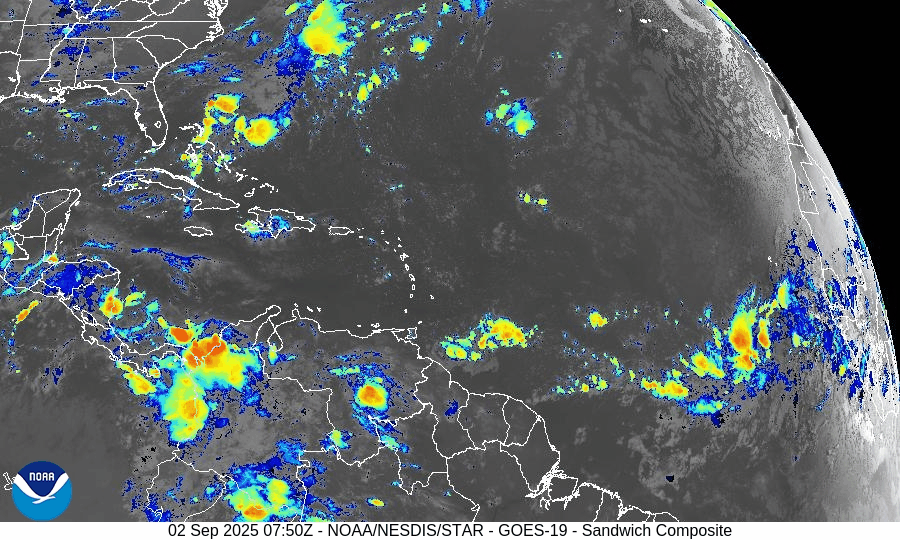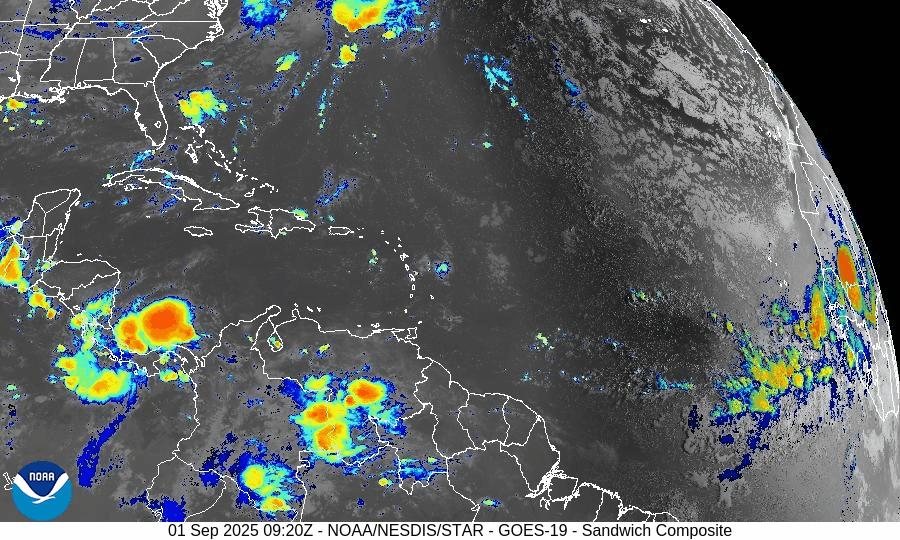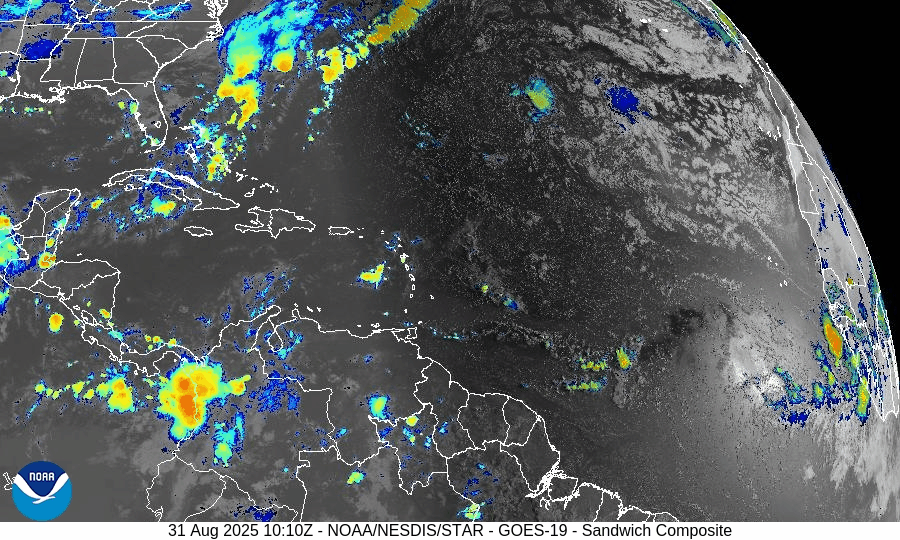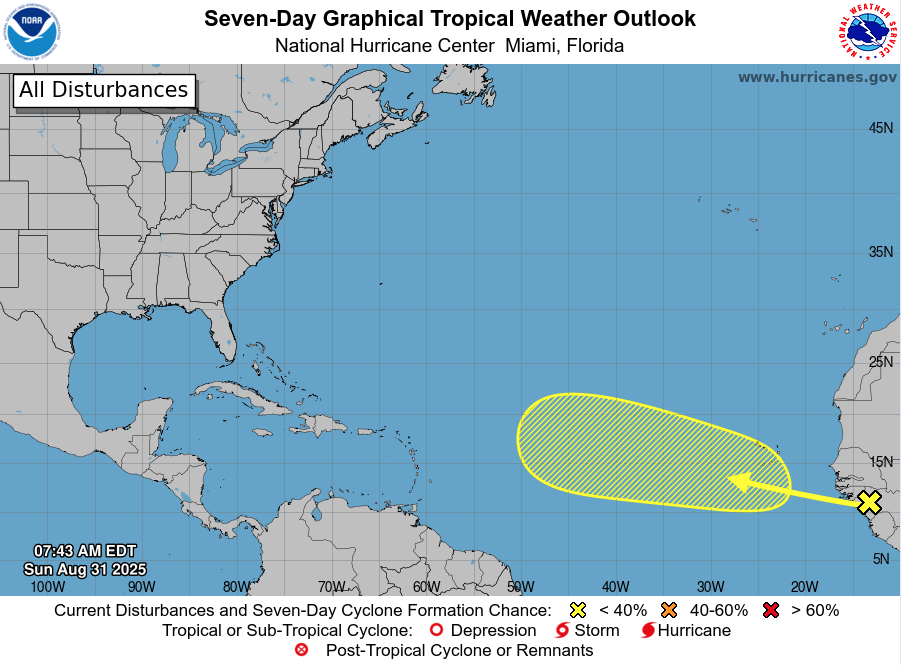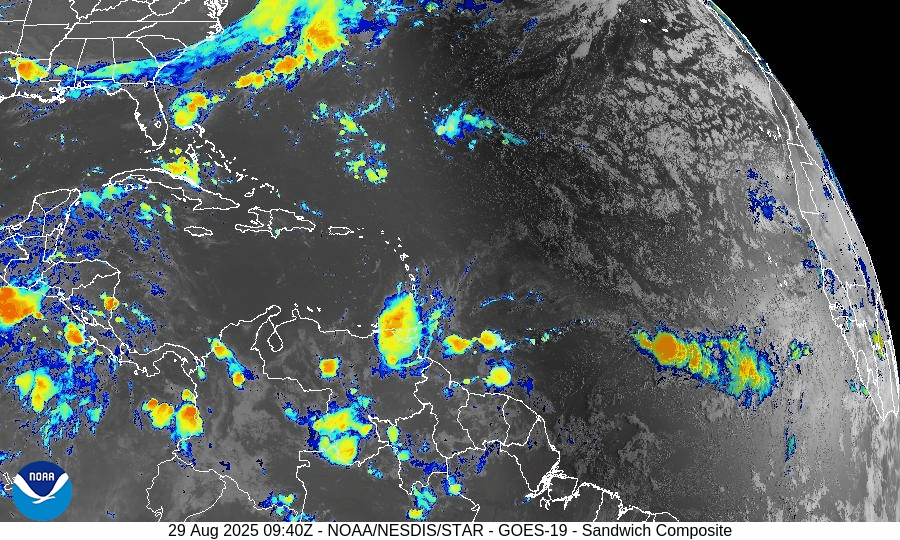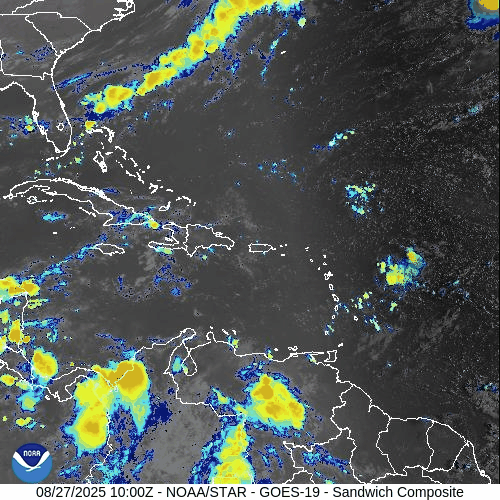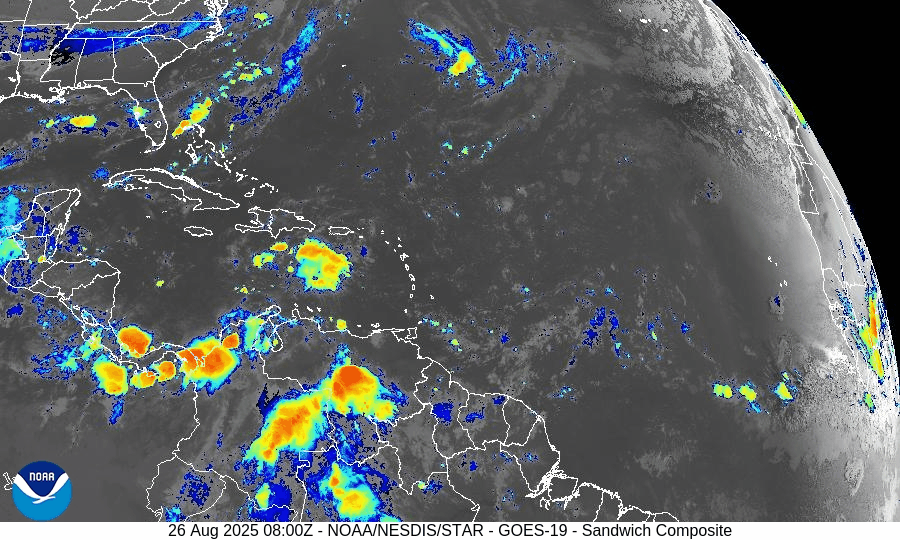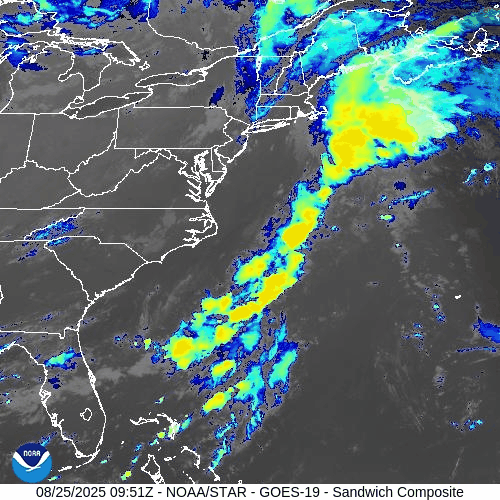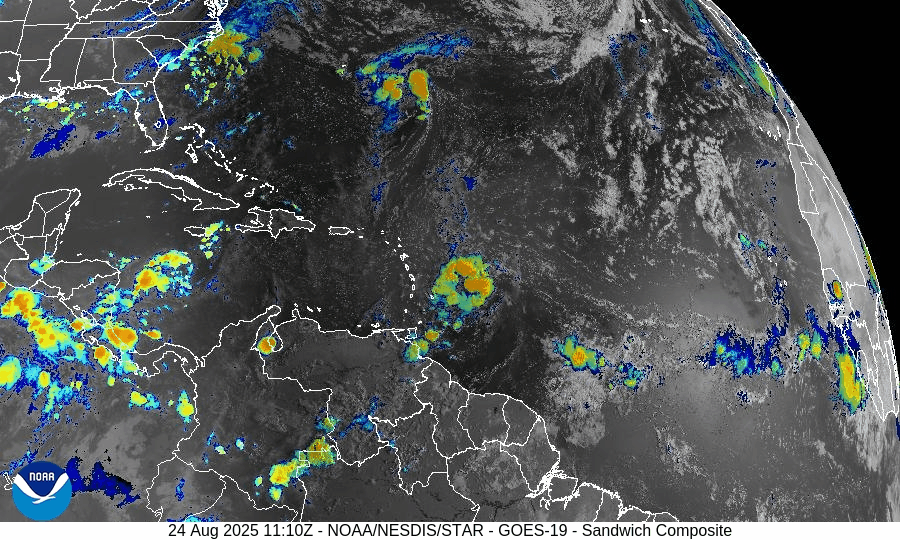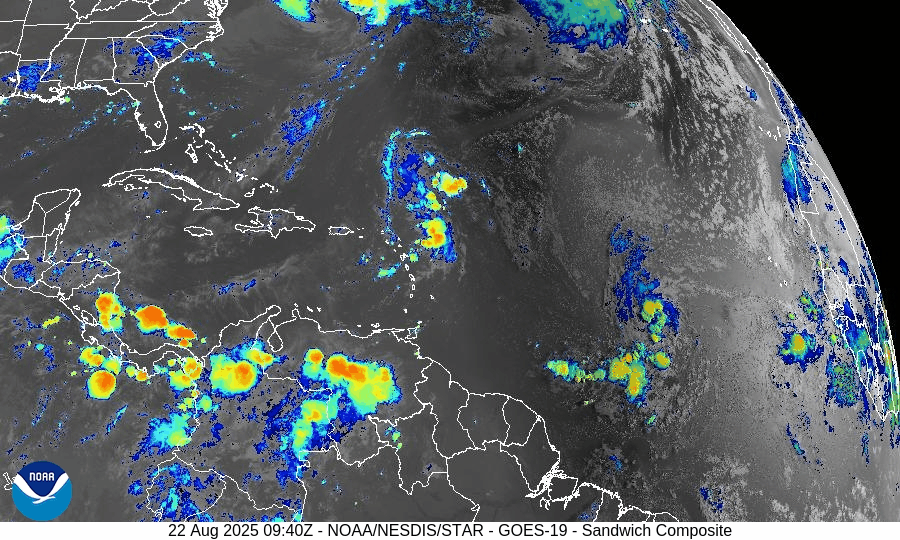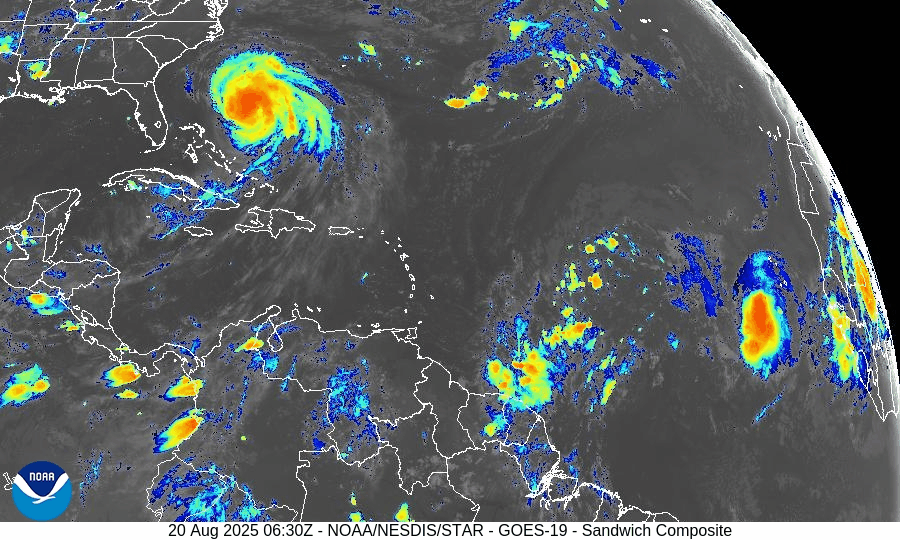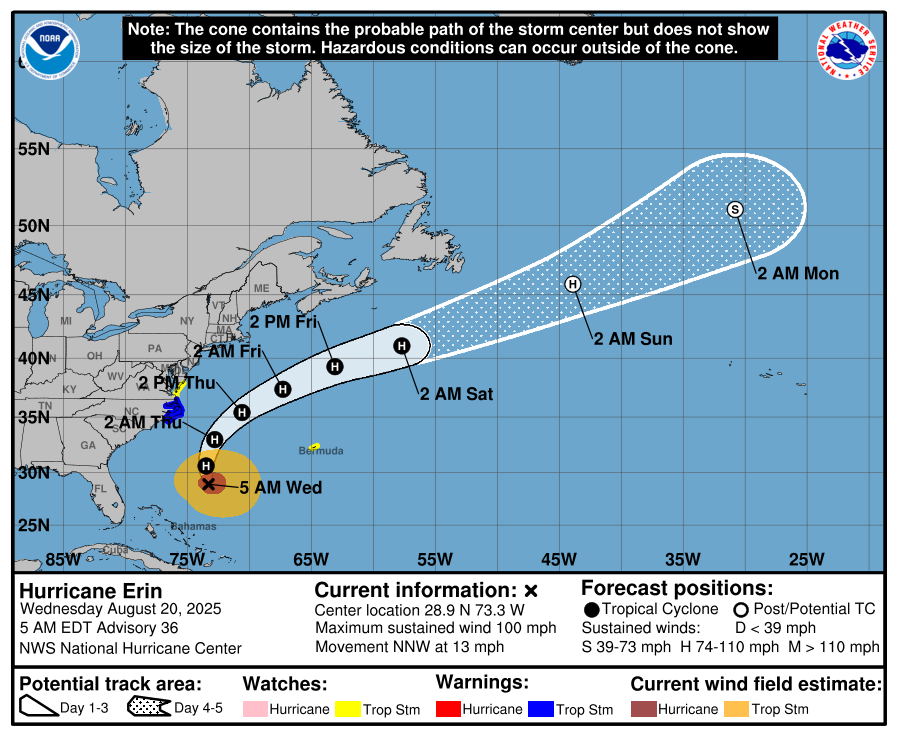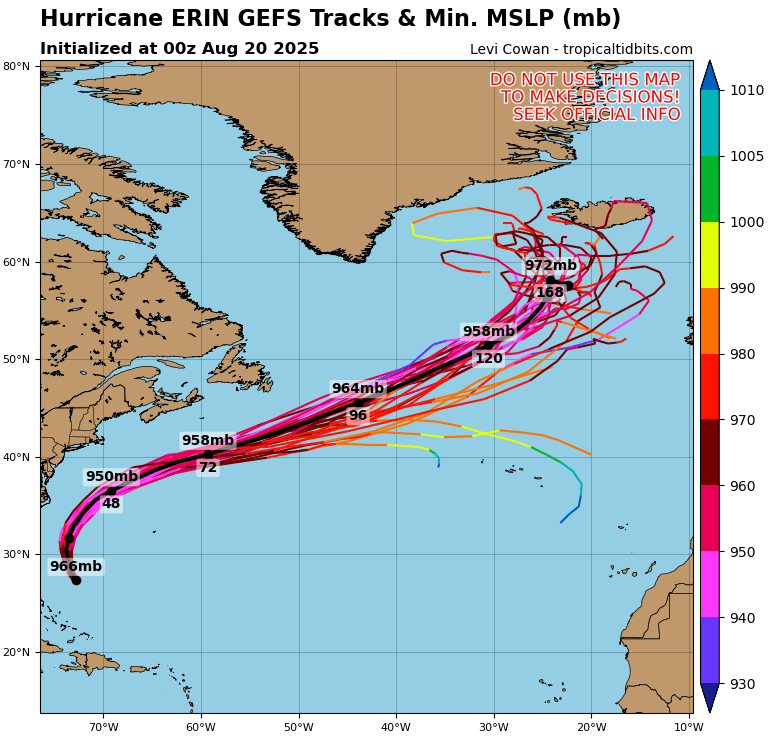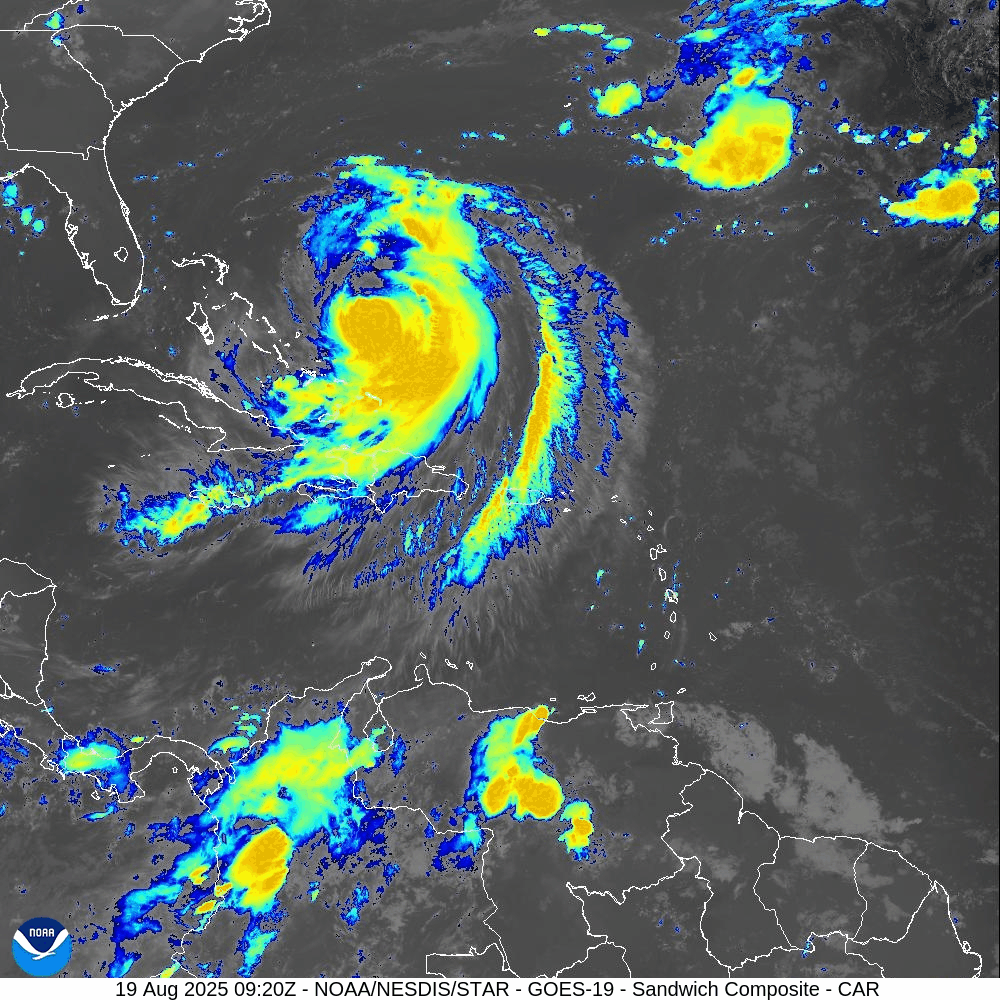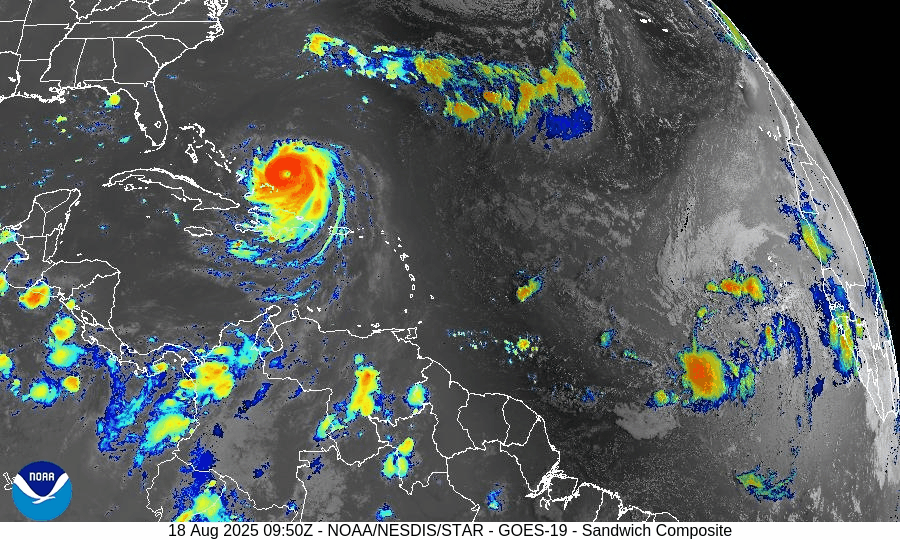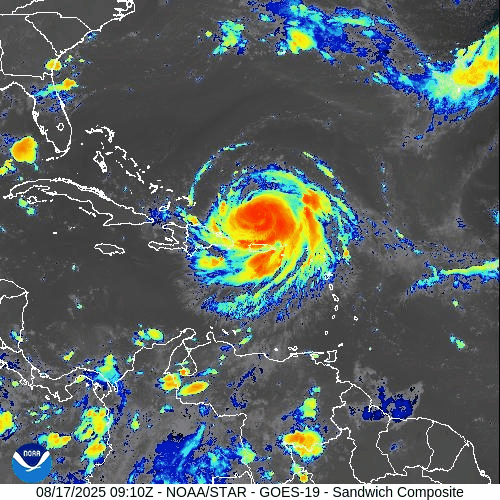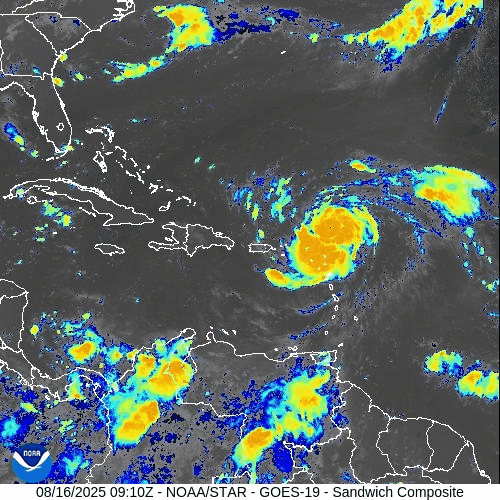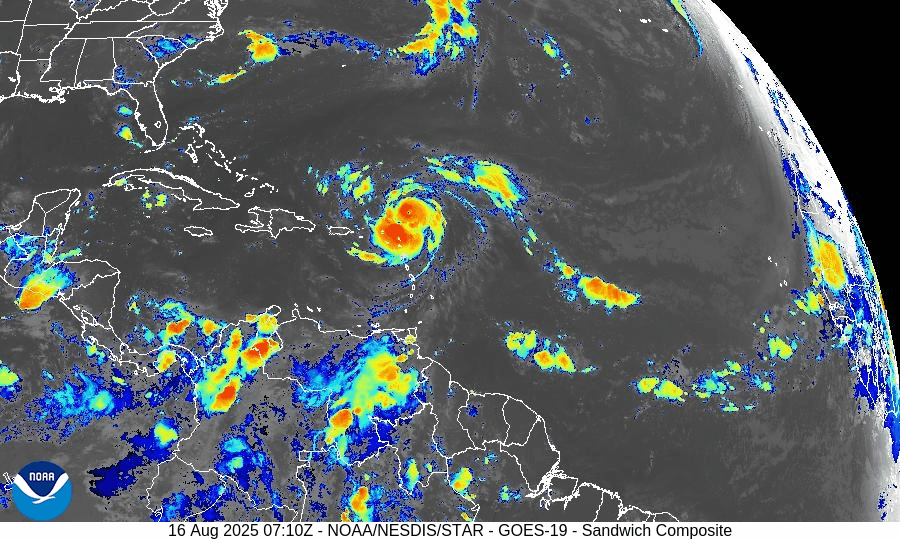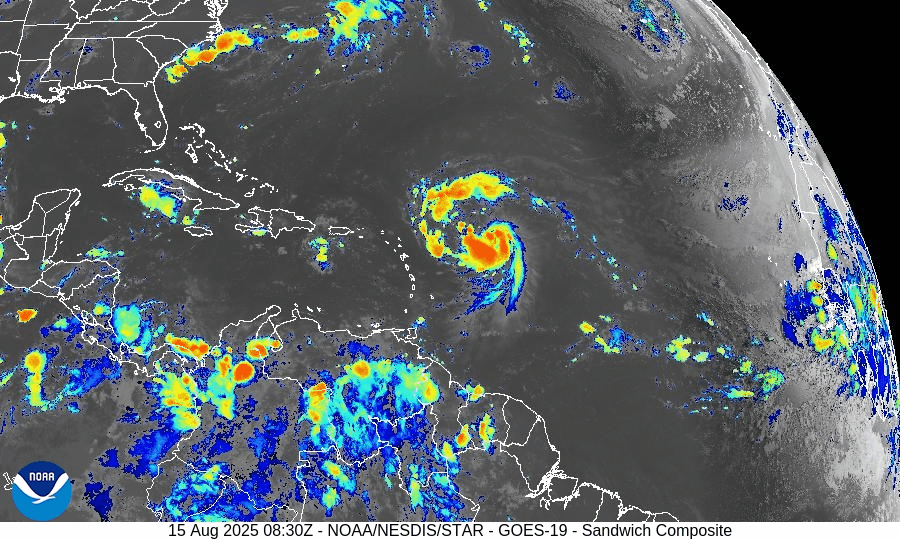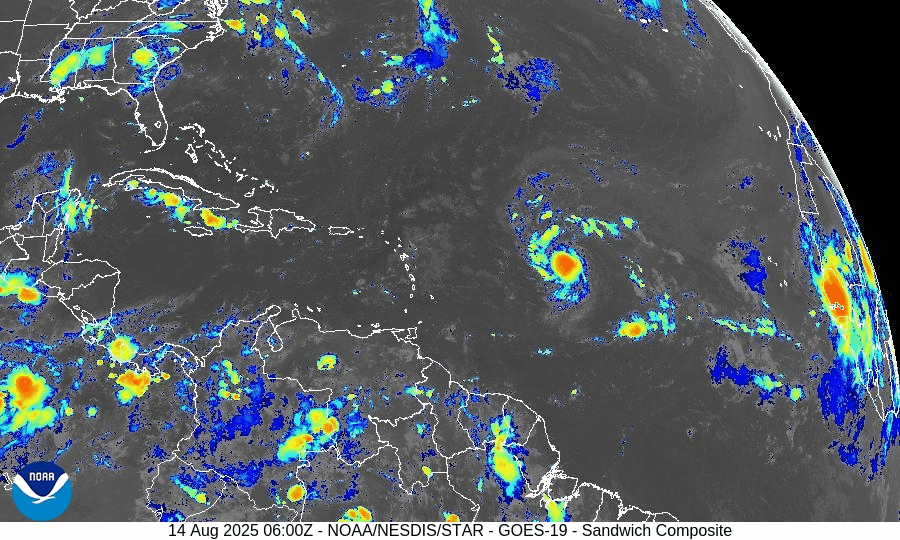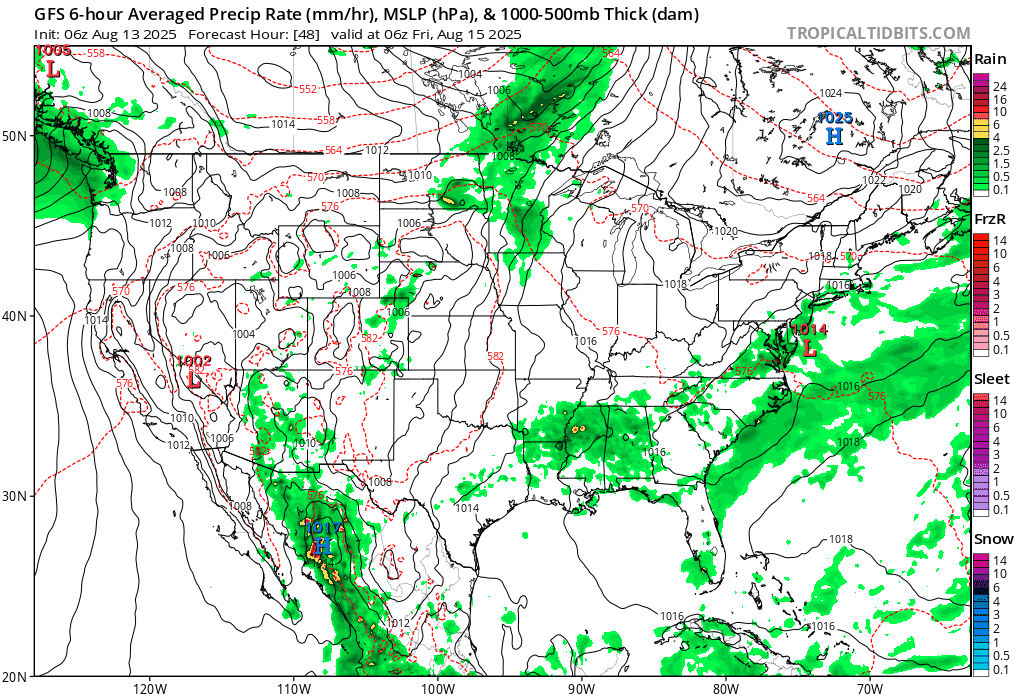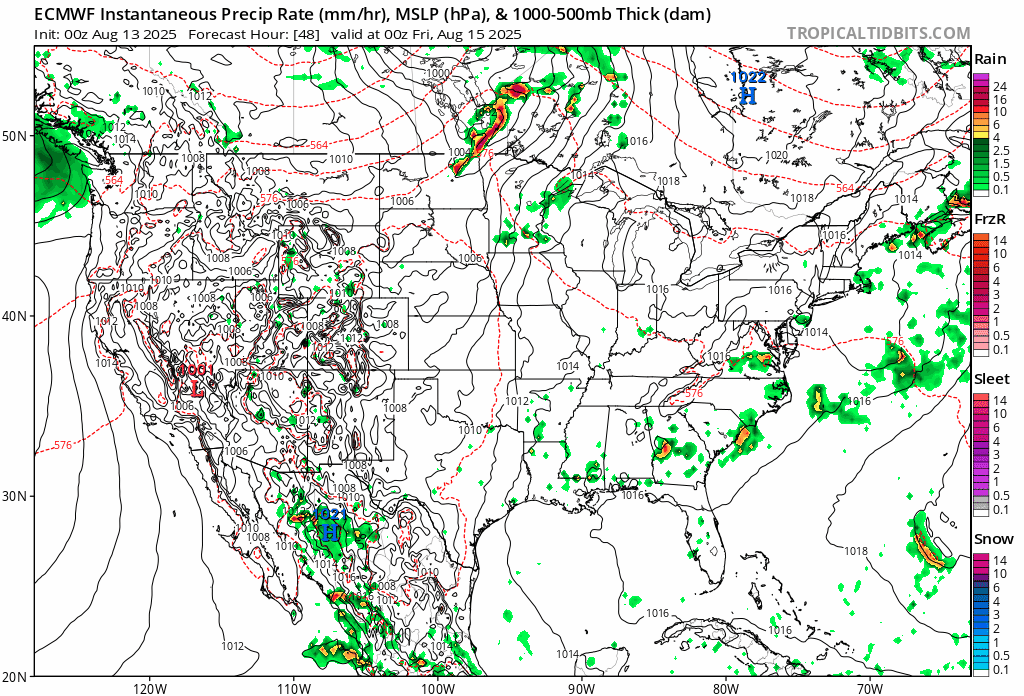Atlantic Hurricane Outlook – September 7, 2025
On September 7, the Atlantic remains completely calm with no tropical storms or hurricanes. The National Hurricane Center expects no development over the next 7 days. A weak tropical wave in the central Atlantic is producing scattered showers but shows no signs of organization. Florida and the Gulf of Mexico remain quiet, experiencing only typical late-summer thunderstorms.
**We’re back after a series of technical issues. We apologize for the inconvenience.
TLDR Version: Click Here
Atlantic remains quiet with no tropical development expected in the next week
Atlantic Basin Overview
No Active Storms
The Atlantic basin is completely calm—no tropical depressions, storms, or hurricanes are present. The NHC advises that no tropical cyclone formation is expected over the next seven days.Tropical Waves Noted
A central Atlantic wave near 41°W and 17°N, moving west at 10–15 kt, shows scattered moderate convection—but no sign of imminent development.
Environmental Conditions
Sea Surface Temperatures (SSTs): Still warm across the Gulf and Caribbean (~29–31 °C), but less favorable in the open Atlantic.
Wind Shear: Elevated winds aloft continue across the basin, suppressing convective organization.
Mid-Level Humidity & SAL: Dry air and Saharan dust remain widespread, further limiting storm initiation.
Gulf of Mexico & Caribbean
The Gulf remains quiet and stable, with only typical afternoon sea-breeze thunderstorms occurring along coastal areas. No tropical systems are expected to develop.
Florida & Southeast U.S. Forecast
Florida continues under a late-summer pattern—hot, humid, and featuring scattered afternoon thunderstorms. With no systems nearby and improving sea conditions, no enhanced coastal risks are currently expected.
Rain forecast visualization courtesy of Windy.com
Summary
The Atlantic basin remains quiet, with no active systems or expected development in the short term.
Although tropical waves are present, environmental factors (warm SSTs excluded) are largely unfavorable across the basin.
The Gulf and Florida remain unaffected, experiencing only routine summertime weather.
TL;DR – September 7 Snapshot
No storms in the Atlantic; no development expected for 7 days.
A wave in the central Atlantic shows no signs of imminent organization.
Environmental factors continue to suppress new tropical formation.
Florida and Gulf remain calm with only routine weather patterns.
Atlantic Hurricane Outlook – September 4, 2025
On September 4, the Atlantic basin remains quiet with no active storms. The main feature is a tropical wave west-southwest of Cabo Verde, showing signs of organization. The NHC gives it a 50% chance of becoming a tropical depression within 48 hours and 80% within 7 days. It is expected to move west to west-northwest and could approach the eastern Caribbean by mid-next week. The Gulf of Mexico and Florida remain calm, experiencing only typical summer thunderstorms.
TLDR Version: Click Here
Atlantic quiet overall; tropical wave WSW of Cabo Verde likely to become a depression this weekend
Atlantic Basin Overview
Eastern Atlantic disturbance (near 34°W)
Showers and storms tied to a tropical wave several hundred miles west-southwest of the Cabo Verde Islands are getting a bit better organized. The NHC says environmental conditions are conducive for development, and a tropical depression is likely late this week or this weekend as the wave moves W–WNW ~5–10 mph. It should accelerate westward afterward and reach waters east of the Lesser Antilles by mid-next week. Formation odds: 50% (48 hr) and 80% (7 days).
No other active systems
Aside from this wave, no tropical cyclones are active in the Atlantic this morning per NHC outlooks.
Environmental Conditions
Sea Surface Temperatures (SSTs): Warm waters persist across the deep tropics, with widespread warmth expected to favor development as the wave travels west. (NHC notes “conducive” conditions for this system.)
Wind Shear: Broad Atlantic shear has been on the higher side recently, but guidance and outlooks indicate a more favorable pocket near the wave, aligning with the NHC’s expectation of gradual organization.
Mid-level Humidity & SAL: Dry air/Saharan dust remain scattered across the central Atlantic and have been suppressing convection in other waves; conditions are less hostile near the developing disturbance than earlier this week.
Large-scale pattern: Forecasters expect upticks in Atlantic activity in early September given unusually warm waters and supportive intraseasonal signals; still, track confidence for any single wave is low at this lead time.
Gulf of American (Mexico) & Caribbean
The Gulf remains quiet under relatively benign marine conditions; no tropical development is indicated in current NHC products. Offshore forecasts keep light winds and low seas (generally ≤3 ft) through the period.
Florida & Southeast U.S. Forecast
General pattern: Hot, humid late-summer weather with the daily sea-breeze cycle of scattered afternoon thunderstorms continues. No tropical threats for the state are signalled by NHC at this time. (Central Florida forecast discussions also note a lingering boundary with showers/storms, trending a bit drier into the weekend.)
Rain forecast visualization courtesy of Windy.com
Summary
A tropical wave WSW of Cabo Verde has 50% (48 hr) / 80% (7-day) odds to form; a depression is likely late week/weekend as it tracks W–WNW.
No other active tropical cyclones in the Atlantic this morning.
Environment: warm SSTs and a somewhat improved shear/moisture backdrop near the wave support gradual development, but SAL/dry air remain pockets of resistance elsewhere.
Gulf and Florida: quiet from a tropical standpoint; typical afternoon storms, light marine winds, and low seas prevail.
TL;DR – September 4 Snapshot
High-confidence watch: Wave WSW of Cabo Verde likely to become a depression late week/weekend; 80% 7-day odds.
Track window: Guidance favors a west to west-northwest motion toward the east of the Lesser Antilles by mid-next week (too early for specifics).
No other systems active; Gulf & Florida remain in a routine summer pattern with scattered storms and no tropical threats.
Atlantic Hurricane Outlook – September 3, 2025
On September 3, the Atlantic basin remains free of active tropical cyclones. A tropical wave emerging from Africa is showing increased signs of organization, with the NHC assigning a 70% chance of development over the next week. This system could become Tropical Depression Seven or Tropical Storm Gabrielle. Florida and the Gulf of Mexico remain quiet, experiencing only typical late-summer thunderstorms.
TLDR Version: Click Here
Atlantic remains quiet; African wave now has 70% 7-day development odds
Atlantic Basin Overview
No Active Storms
The Atlantic basin continues to be free of active tropical cyclones—no storms are currently present.Tropical Wave Off Africa
A tropical wave exiting Africa is gaining strength. The NHC now gives this system a 0% development chance in 48 hours, rising to 70% over 7 days. Development into Tropical Depression Seven—and possibly Tropical Storm Gabrielle—is considered likely by the weekend.
Environmental Conditions
Sea Surface Temperatures (SSTs): Remain warm in the Caribbean and Gulf (about 29–31 °C) but cooler farther east, where the African wave is located.
Wind Shear: Moderate to strong shear persists across much of the Atlantic but may ease near the developing wave.
Mid-Level Humidity & SAL: Dry air and the Saharan Air Layer (SAL) are widespread, but are expected to diminish along the wave’s path as it tracks westward.
Gulf of America (Mexico) & Caribbean
The Gulf remains quiet, dominated by high pressure. Only routine afternoon thunderstorms are expected along coastal areas; no tropical development is expected at this time.
Florida & Southeast U.S. Forecast
Florida continues with typical early-September weather: hot and humid, with scattered sea-breeze-driven afternoon thunderstorms. No tropical threats are expected. Coastal waters are calmer as the Atlantic’s longtime surf persists from prior systems but gently subsides.
Rain forecast visualization courtesy of Windy.com
Summary
Atlantic basin remains calm with no systems currently active.
A tropical wave off Africa shows a high (70%) chance of developing into a tropical cyclone within 7 days.
Environmental factors—warm SSTs but competing dry air, SAL, and wind shear—will determine if and when development occurs.
Gulf and Florida remain storm-free and continue typical late-summer weather patterns.
TL;DR – September 3 Snapshot
Atlantic is quiet with no storms.
African wave now has 70% development odds over the next 7 days.
Atlantic environment remains marginal but improving near the wave.
Florida and Gulf remain calm with routine storms.
Atlantic Hurricane Outlook – September 2, 2025
On September 2, the Atlantic remains storm-free with no active tropical cyclones. A tropical wave emerging off the coast of Africa shows rising organization and carries a 70% chance of development within 7 days. Environmental conditions are gradually improving, though dry air and Saharan dust remain factors. The Gulf of Mexico and Florida stay calm with only typical early-September thunderstorms.
TLDR Version: Click Here
Atlantic remains quiet; African wave gaining strength with a 70% 7-day development chance
Atlantic Basin Overview
No Active Storms
The Atlantic basin remains clear of any active tropical cyclones.Tropical Wave Emerging off Africa
A tropical wave located south of the Cabo Verde Islands is showing signs of organization. Environmental conditions are becoming more favorable, prompting a forecast of a low 30% chance of formation in the next 48 hours, rising significantly to a high 70% chance of development over the next 7 days.
Environmental Conditions
Sea Surface Temperatures (SSTs): Remain warm (~29–31 °C) in the Caribbean and Gulf, supportive for tropical development. Cooler conditions persist in the open Atlantic.
Wind Shear: Moderate to strong across much of the Atlantic; however, shear is forecast to ease gradually across the eastern tropical Atlantic, aiding organization of the wave.
Mid-Level Humidity & SAL: While dry air and Saharan Dust (SAL) remain present, pockets of increasing moisture near the African wave are aiding its potential development.
Gulf of America (Mexico) & Caribbean
The Gulf remains quiet, dominated by high pressure. Expect only daily sea-breeze afternoon thunderstorms—no tropical development is anticipated.
Florida & Southeast U.S. Forecast
Florida continues with typical early-September weather—hot, humid, and prone to scattered afternoon thunderstorms. There are no tropical threats or coastal hazards affecting the state at this time.
Rain forecast visualization courtesy of Windy.com
Summary
Atlantic basin remains calm, but one African wave shows high development potential (70%) over 7 days.
Environmental factors including SSTs, shear, moisture, and SAL will determine whether it organizes.
Gulf and Florida experience routine late-summer weather; no tropical systems in the near term.
TL;DR – September 2 Snapshot
Atlantic quiet with no storms.
70% chance a wave near Africa develops in the next 7 days.
Warm SSTs but competing shear and dry air—watch environment closely.
Florida and Gulf remain in standard summer pattern.
Atlantic Hurricane Outlook – September 1, 2025
On September 1, the Atlantic remains storm-free with no active cyclones. A tropical wave emerging off the coast of Africa carries a 40% chance of development over the next 7 days. While environmental conditions—wind shear, dry air, and Saharan dust—are suppressing rapid growth, the wave will be monitored closely. Florida and the Gulf of Mexico remain quiet, experiencing only typical early-September thunderstorms.
TLDR Version: Click Here
Atlantic remains quiet; tropical wave off Africa shows rising potential (40% over 7 days)
Atlantic Basin Overview
No Active Storms
There are currently no active tropical cyclones in the Atlantic basin—the first tranquil period we've seen since the wake of Fernand and Erin.Emerging Tropical Wave Off Africa
A new tropical wave has emerged off the West Coast of Africa near Guinea-Bissau. Presently disorganized, the NHC assigns it a 0% chance of development in the next 48 hours, but the probability rises to about 40% over the next 7 days. This system will be closely monitored as it moves west across the tropical Atlantic.
Environmental Conditions
Sea Surface Temperatures (SSTs): Remain warm in the Gulf and Caribbean (29–31 °C), while the open Atlantic heat content diminishes northward.
Wind Shear: Elevated shear across much of the basin continues to suppress storm formation.
Mid-Level Humidity & SAL (Saharan Air Layer): Dry air and SAL dust are widespread, inhibiting significant convection and limiting the strength of the new wave emerging off Africa.
Gulf of America & Caribbean
The Gulf remains stable and quiet, under the influence of high pressure. Only routine afternoon sea-breeze thunderstorms are expected—no tropical threats are present.
Florida & Southeast U.S. Forecast
Florida continues in its trademark late-August/early-September pattern: hot, humid, with scattered afternoon thunderstorms. With no active systems nearby, no coastal or tropical threats are expected this week.
Rain forecast visualization courtesy of Windy.com
Summary
No storms are currently active in the Atlantic basin.
A tropical wave off Africa is being monitored, with a 40% chance of developing within 7 days.
Environmental factors—including cool SSTs, strong shear, dry air, and SAL—are suppressing tropical development.
Gulf and Florida remain quiet, with only standard summertime weather patterns in play.
TL;DR – September 1 Snapshot
Atlantic is fully quiet; no active storms.
Tropical wave off Africa now has 40% 7-day development odds.
Hostile conditions in place, limiting immediate storm formation.
Florida and Gulf remain calm, aside from typical daily thunderstorms.
Atlantic Hurricane Outlook – August 31, 2025
On August 31, the Atlantic remains storm-free following the dissipation of Fernand and Erin’s exit. The only feature of interest is a tropical wave moving off Africa, with a low 30% development chance over the next 7 days. Environmental conditions—wind shear, dry air, and Saharan dust—continue to limit storm formation. Florida and the Gulf remain calm aside from typical summer storms.
TLDR Version: Click Here
Atlantic basin remains quiet; a weak wave off Africa shows low (30%) development odds
Atlantic Basin Overview
No Active Storms
There are currently no active tropical cyclones in the Atlantic basin. The calm continues following Fernand’s dissipation and the end of Erin’s impacts.Tropical Wave Near Africa
A tropical wave is forecast to emerge off the west coast of Africa, and the NHC assigns it a low – but not negligible – chance of development: 0% over the next 2 days, increasing to 30% over the next 3 to 7 days.
Environmental Conditions
Sea Surface Temperatures (SSTs): Warm in the Caribbean and Gulf (~29–31 °C), but less favorable conditions in much of the open Atlantic.
Wind Shear: Continues to be elevated across large swaths of the basin, discouraging storm formation.
Mid-Level Humidity & SAL: Dry air and Saharan dust (SAL) remain prevalent, further suppressing convective activity.
Gulf of Mexico & Caribbean
The Gulf remains quiet and stable, dominated by high pressure. Only routine afternoon thunderstorms are occurring along the coasts—no tropical development is expected.
Florida & Southeast U.S. Forecast
Florida continues in its late-August pattern—hot, humid, with scattered afternoon thunderstorms. No tropical threats are present.
Beaches along the Atlantic coast are beginning to calm. With no new swells incoming, rip currents and surf conditions are generally improving, though caution remains prudent in areas still unsettled from earlier systems.
Rain forecast visualization courtesy of Windy.com
Summary
Atlantic basin is currently calm, with no tropical storms or hurricanes active.
A new tropical wave off Africa carries low (30%) development odds over the next week.
Environmental factors (cooler SSTs, shear, dry air, and SAL) continue to limit development potential.
Gulf and Florida remain storm-free, apart from the usual summer thunderstorms.
TL;DR – August 31 Snapshot
The Atlantic is quiet and free of active storms.
A wave off Africa has low (30%) chance of development by next week.
Environmental conditions remain unfavorable for new formations.
Florida and Gulf remain calm with only routine seasonal storms.
Atlantic Hurricane Outlook – August 29, 2025
On August 29, Fernand dissipated in the far North Atlantic, marking the first quiet period in weeks across the basin. No tropical systems are active, though a weak wave off Africa shows low development potential. The Gulf of Mexico and Florida remain calm, experiencing only routine summer thunderstorms.
TLDR Version: Click Here
Fernand has dissipated; no active tropical storms, but a new wave off Africa warrants monitoring
Atlantic Basin Overview
Fernand Has Dissipated
Post-tropical Fernand has fully dissipated over the far North Atlantic. As of the last advisory on August 28, 0900 UTC, it was centered near 41.2°N, 42.9°W, moving east-northeast at ~23 mph with maximum winds of 35 knots (40 mph) and a minimum pressure of 1009 mb. No further advisories will be issued, and the system is no longer a threat to land.
No Active Tropical Systems
Currently, there are no active tropical storms or hurricanes in the Atlantic basin. Model tracking tools confirm the basin is completely clear of active systems.
New Disturbance Emerging Near Africa
The NHC is observing a tropical wave east of the Cabo Verde Islands. This wave features no significant convection and is currently under the influence of Saharan dust. While its development odds are low in the short term, there’s a 20% chance of development over the next 7 days.
Environmental Conditions
Sea Surface Temperatures (SSTs): Warm waters (~29–31 °C) persist in the Gulf and Caribbean, but cooling temperatures across the open Atlantic now that Fernand is gone.
Wind Shear: Elevated wind shear continues to suppress development across most of the Atlantic.
Mid-Level Relative Humidity & Saharan Air Layer (SAL): Dry air and SAL dust are prevalent—particularly near the new wave off Africa—further hampering development.
Gulf of America (Mexico) & Caribbean
The Gulf remains quiet and stable, with high pressure dominating. Only typical afternoon thunderstorms are expected; no organized or tropical development is forecast.
Florida & Southeast U.S. Forecast
Florida continues to experience standard late-summer weather—hot, humid, with scattered afternoon thunderstorms. The absence of major tropical features means no new coastal threats.
Atlantic beaches are finally beginning to calm after prolonged rough surf from previous systems, though caution remains advised where noticeable wave action persists.
Rain forecast visualization courtesy of Windy.com
Summary
Fernand has dissipated; no tropical cyclones remain in the Atlantic.
Atlantic remains quiet, with only a small wave emerging near Africa carrying limited development potential.
Environmental factors—cooler SSTs, wind shear, dry air, and SAL—continue to suppress tropical activity.
Gulf and Florida show no signs of tropical development, carrying on with typical summer weather patterns.
TL;DR – August 29 Snapshot
Fernand is no longer active and poses no threat.
Atlantic basin is quiet—only a minor wave off Africa is being watched.
Environmental conditions remain unfavorable for storm formation.
Florida and Gulf continue with routine stormy weather; beaches are calming.
Atlantic Hurricane Outlook – August 27, 2025
On August 27, Tropical Storm Fernand transitioned into a post-tropical system southeast of Newfoundland. While Fernand poses no threat to land, Erin’s long-period swells continue to drive dangerous surf and rip currents from the Carolinas through New England. Florida and the Gulf of Mexico remain calm, with only typical late-August thunderstorms and no signs of tropical development.
TLDR Version: Click Here
Tropical Storm Fernand becomes post-tropical over open waters; East Coast surf threats persist
Atlantic Basin Overview
Tropical Storm Fernand
As of 5 AM AST (0900 UTC), Fernand is situated near 38.3° N, 50.8° W, approximately 590 miles southeast of Cape Race, Newfoundland. The system carries sustained winds of 45 mph, is moving east at 12 mph, and maintains a central pressure of 1007 mb.
No coastal watches or warnings are active. Fernand is expected to transition into a post‑tropical system later today, then evolve into a trough and dissipate by Thursday.
Hurricane Erin’s Lingering Surf Impacts
Despite being long gone, Erin's energy continues to affect coastal waters. East Coast beaches—from the Carolinas through New England—continue to experience rough surf and dangerous rip currents.
No Other Tropical Activity
There are no new tropical disturbances of concern at this time, and forecast models show an inactive Atlantic basin in the short term.
Environmental Conditions
Sea Surface Temperatures (SSTs): Waters remain warm in the subtropics but are cooling northward—supporting Fernand's decay.
Wind Shear: Moderate winds aloft are increasing and will help dissipate Fernand.
Mid-Level Humidity & SAL: Dry air and dust from the Saharan Air Layer still suppress convection across the Atlantic, limiting new storm formation.
Gulf of Mexico & Caribbean
The Gulf remains quiet and stable, dominated by high pressure. Afternoon thunderstorms continue in coastal areas, but no tropical development is expected.
Florida & Southeast U.S. Forecast
Typical late-August weather prevails: hot and humid with scattered afternoon storms across Florida.
Beaches along the Atlantic continue to face elevated rip current risks, driven by the lingering swell from Erin and residual energy from Fernand.
Rain forecast visualization courtesy of Windy.com
Summary
Fernand weakens as it becomes post-tropical; no land threat.
Erin’s surf legacy continues to endanger East Coast recreation.
Atlantic basin remains quiet—no new systems.
Gulf and Florida are calm aside from routine summer storms.
Hostile environmental conditions (cooler SSTs, shear, dry air, SAL) limit development.
TL;DR – August 27 Snapshot
Fernand becomes post-tropical in the open ocean—no land threat.
Rip currents and rough surf continue to challenge East Coast beaches.
Active development unlikely; Atlantic remains quiet.
Florida and Gulf of Mexico see only typical summer storms.
Atlantic Hurricane Outlook – August 26, 2025
On August 26, Tropical Storm Fernand weakened over cooler waters east-northeast of Bermuda and is expected to become post-tropical by Wednesday. While Fernand poses no threat to land, Erin’s swells are still driving dangerous rip currents along the U.S. East Coast. Florida and the Gulf of Mexico remain quiet, experiencing only typical late-August thunderstorms.
TLDR Version: Click Here
Tropical Storm Fernand weakens offshore; Erin’s surf legacy lingers while tropics turn quiet
Atlantic Basin Overview
Tropical Storm Fernand
As of Tuesday morning, Fernand is located about 635 miles east-northeast of Bermuda, moving northeast at ~14 mph with maximum sustained winds near 45 mph and a central pressure of 1005 mb. The storm has weakened over cooler waters and moderate shear, and is forecast to transition into a post-tropical system by Wednesday, dissipating altogether by Thursday. No watches or warnings are in effect, and Fernand poses no threat to land.
Hurricane Erin’s Legacy
Though Erin has been gone for days, its immense size and powerful wave field continue to leave a footprint along the East Coast. Long-period swells and dangerous rip currents remain a hazard from the Carolinas through New England, particularly in areas with open exposure to the Atlantic.
Other Atlantic Activity
The National Hurricane Center reports no active disturbances of concern. A tropical wave that had entered the Caribbean has been choked off by dry air and shear, with 0–10% development odds over the next week
Environmental Conditions
Sea Surface Temperatures (SSTs): The Caribbean and Gulf remain very warm (29–31 °C), supportive of storm formation. In the North Atlantic, Fernand is moving into cooler waters, which will force weakening.
Wind Shear: Shear is moderate over Fernand and forecast to increase, hastening its post-tropical transition. Stronger shear persists across much of the MDR, suppressing new development.
Mid-Level Relative Humidity: Dry mid-level air continues across the central Atlantic, limiting convective organization for any tropical waves.
Saharan Air Layer (SAL): Dust-laden air spans the eastern and central Atlantic, further capping deep convection and hindering tropical development.
Gulf of Mexico & Caribbean
The Gulf remains quiet under high pressure, with no signs of organized development. Only routine afternoon thunderstorms are occurring along coastal regions. Despite very warm waters, the Gulf shows no near-term tropical threats.
Florida & Southeast U.S. Forecast
Florida is under a typical late-August pattern: hot, humid conditions with scattered afternoon thunderstorms driven by sea breezes. Some morning showers are possible along the Gulf Coast.
Along the Atlantic beaches, hazardous surf and rip currents remain the main concern, with energy still propagating from Erin’s remnants and Fernand’s offshore circulation
Rain forecast visualization courtesy of Windy.com
Summary
Fernand has weakened to a 45 mph storm and will become post-tropical by Wednesday.
Erin’s legacy continues to affect the East Coast with dangerous surf and rip currents.
No new Atlantic systems show signs of development; odds remain very low.
Gulf of Mexico and Florida are quiet, with only routine late-summer storms.
Environmental conditions: Warm SSTs but hostile shear, dry air, and SAL are suppressing new activity.
TL;DR – August 26 Snapshot
Fernand weakens offshore; no land impacts expected.
Erin’s swells continue to fuel rip currents along the East Coast.
SAL, dry air, and wind shear are limiting new storm development.
Gulf and Florida remain quiet aside from typical thunderstorms.
Atlantic Hurricane Outlook – August 25, 2025
Tropical Storm Fernand continues east of Bermuda with sustained winds near 50 mph and will weaken as it moves into cooler waters. Erin’s legacy swells still drive dangerous surf and rip currents from the Carolinas to New England. Florida and the Gulf remain calm, with only routine summer thunderstorms.
TLDR Version: Click Here
Tropical Storm Fernand holds strength offshore; environmental factors limit wider Atlantic development
Atlantic Basin Overview
Tropical Storm Fernand
Fernand is located about 360 miles east-northeast of Bermuda, carrying sustained winds near 50 mph while moving north-northeast at ~12 mph. The system may strengthen slightly today but will soon encounter cooler waters and stronger upper-level winds, leading to weakening and a transition to a post-tropical cyclone by midweek. No coastal warnings are in effect, and Fernand poses no threat to land.
Hurricane Erin’s Legacy
Erin’s powerful circulation has long dissipated, but the swell energy lingers. Beaches from the Carolinas to New England remain at risk for dangerous rip currents, elevated surf, and localized erosion, even as skies improve inland.
Other Atlantic Activity
A tropical wave in the Caribbean and another in the central Atlantic show low development chances. The NHC assigns only a 10% probability of tropical formation through 7 days. Dry air and hostile shear continue to suppress organization.
Gulf of America (Mexico) & Caribbean
The Gulf is quiet under high pressure with only routine afternoon thunderstorms along the coast. Very warm waters (29–31 °C) cover the basin, but no tropical development is expected in the near term.
Florida & Southeast U.S. Forecast
Florida remains locked in a late-August cycle: hot, humid conditions and scattered afternoon thunderstorms driven by the sea breeze. Some areas also see morning showers drifting in from the Gulf, making for a two-phase rain pattern.
No tropical threats are present, but Atlantic beaches continue to face rip current risks due to Fernand’s swells and Erin’s lingering wave action.
Rain forecast visualization courtesy of Windy.com
Environmental Conditions
Sea Surface Temperatures (SSTs): The Caribbean and Gulf of Mexico are running 29–31 °C (84–88 °F), supportive of development. In the western Atlantic, SSTs are warm enough to sustain Fernand briefly, but cooler waters to the north will drive weakening.
Wind Shear: Currently low to moderate around Fernand, allowing some maintenance of strength. However, increasing shear northward will disrupt convection and hasten its post-tropical transition. Shear also remains moderate to strong across much of the MDR, suppressing other disturbances.
Mid-Level Relative Humidity (RH): Dry air pockets persist in the central Atlantic, limiting organization of Invest 99L and other waves. Moisture is more favorable closer to the Caribbean and Gulf.
Saharan Air Layer (SAL): SAL dust continues to intrude across parts of the eastern and central Atlantic, reducing convection and capping development potential.
Summary
Fernand is a 50 mph tropical storm, staying well offshore and weakening by midweek.
Erin’s swells continue to fuel dangerous surf and rip currents along the East Coast.
Environmental conditions (SSTs supportive, but SAL, dry mid-level air, and increasing shear) are limiting further Atlantic development.
Gulf and Florida remain quiet, aside from routine thunderstorms and coastal surf hazards.
TL;DR – August 25 Snapshot
Fernand stays offshore, no U.S. land threat, weakening soon.
Rip currents and surf hazards linger along the East Coast.
SAL, shear, and dry mid-level air suppress new storm formation.
Gulf and Florida remain in a routine summer pattern.
As always, check back at CAT5Prep.com for daily hurricane updates, and also visit our Hurricane Prep Blog to find ways you can prepare during hurricanes.
Atlantic Hurricane Outlook – August 24, 2025: Tropical Storm Fernand forms southeast of Bermuda
Tropical Storm Fernand has developed in the Atlantic while Erin’s post-tropical remnants continue to generate hazardous surf and rip currents from the Carolinas to New England. Florida and the Gulf of Mexico remain calm, with only daily sea-breeze thunderstorms expected.
TLDR Version: Click Here
Tropical Storm Fernand forms southeast of Bermuda; environmental conditions shaping its strength and lifespan
Atlantic Basin Overview
Tropical Storm Fernand
A new system, Tropical Storm Fernand, has formed approximately 300–400 miles southeast of Bermuda, with sustained winds near 40 mph and moving north-northeastward at about 15 mph. Forecasts support gradual strengthening, possibly into a hurricane by Monday, before weakening as it encounters cooler waters and increasing wind shear. The projected path keeps Fernand well east of Bermuda and away from land. Multiple long-period swells from Fernand, combined with Erin’s lingering effects, sustain hazardous surf and rip current risks along the U.S. East Coast.
Hurricane Erin’s Lingering Hazards
Although Erin has been post-tropical for days, its legacy endures in dangerous surf and life-threatening rip currents from the Carolinas through New England. Earlier in the week, dune breaches, NC‑12 flooding, and evacuations in the Outer Banks were documented. The ocean hazards persist even as the system moves further away.
Invest 99L
A tropical wave in the central Atlantic (Invest 99L) continues to show only limited organization. Environmental conditions—particularly dry mid-level air and moderate wind shear—are hindering its development.
Environmental Conditions
Sea Surface Temperatures (SSTs): SSTs across the Caribbean and Gulf remain warm (29–31 °C / 84–88 °F), which generally fuels storm development. The Main Development Region (MDR) is also running near or slightly above average SSTs, offering environmental support for intensification.
Wind Shear: As of today, Fernand benefits from light wind shear in the immediate area of formation, although models show increasing wind shear after ~36 hours, which should weaken the system. Moderately high shear in the Caribbean and central Atlantic continues to suppress broader basin-wide development.
Mid-level Humidity & Saharan Air Layer (SAL): While overall moisture in the western tropical Atlantic remains sufficient, pockets of dry mid-level air—partly due to lingering SAL intrusions—are inhibiting storm convection and formation in some areas, including near Invest 99L.
Gulf of America (Mexico) & Caribbean
The Gulf of America (Mexico) remains quiet, with high pressure dominating. Standard afternoon sea-breeze thunderstorms continue along the coast, but no organized tropical development is expected in the near term. SSTs remain very warm (29–31 °C), making the region climatically conducive to storm formation later in the season.
Florida & Southeast U.S. Forecast
Across the Florida Peninsula, it's the usual late-August pattern: hot and humid, with daily sea-breeze thunderstorms. Afternoon rainfall, frequent lightning, and gusty winds persist. No tropical threats are present at this time.
Along the Atlantic coast from Florida to New England, rip current risk remains elevated due to swells generated by both Erin and Fernand. Hazards are expected to continue into early next week—beachgoers should remain cautious and heed local advisories.
Rain forecast visualization courtesy of Windy.com
Summary
Fernand has formed southeast of Bermuda and is expected to strengthen briefly while remaining over open water; weakening is likely within a few days.
Erin’s remnants continue to produce dangerous coastal surf and rip currents, particularly from the Carolinas northward.
Invest 99L shows low development potential due to hostile environmental conditions, including dry air and moderate shear.
Gulf and Florida remain storm-free, with only routine summertime convection.
TL;DR – August 24 Snapshot
Fernand forms and may briefly become a hurricane, but stays out at sea.
Hazardous surf and rip currents continue along the U.S. East Coast from Erin’s legacy.
Development of Invest 99L is stunted by dry air and moderate shear.
Gulf of Mexico and Florida remain calm, with season-typical afternoon storms only.
Atlantic Hurricane Outlook – August 22, 2025:Erin weakens; dangerous surf continues along the East Coast
Hurricane Erin dropped to Category 1 on August 22, 2025, as it moved northeast away from the U.S. coast. Despite weakening, the massive storm continues to drive life-threatening rip currents, high surf, and dune erosion from the Carolinas to New England. The Gulf of Mexico and Florida remain calm, with only typical summer thunderstorms.
TLDR Version: Click Here
Atlantic Basin Overview
Hurricane Erin (Category 1)
Erin has weakened to Category 1 with maximum sustained winds near 90 mph and a central pressure of 956 mb. The storm is moving northeast at 22 mph, well away from the U.S. coastline. Erin is a very large cyclone, with tropical-storm-force winds extending over 350 miles from the center.
Although it is transitioning into a post-tropical system, Erin continues to generate life-threatening surf and rip currents along the East Coast. Coastal flooding and dune overwash were reported on North Carolina’s Outer Banks, including sections of NC-12, but major structural damage has been avoided.Coastal and Marine Impacts
“Life-threatening” rip currents and 10–17 ft seas continue from the Carolinas through New England. Numerous beach rescues have been reported this week, with no-swim advisories in place at several popular beaches such as Wrightsville Beach, NC. Conditions will remain hazardous for swimmers and boaters through the weekend as swells spread north into the Canadian Maritimes.Declining Land Warnings
All U.S. coastal tropical storm warnings have been lifted, and advisories for Bermuda were dropped Thursday. Erin will continue weakening as it accelerates northeast, becoming post-tropical by tonight.Additional Atlantic Disturbances
Disturbance east of the Leeward Islands (90L): Highly likely to develop as it tracks northwest and then north between the Lesser Antilles and Bermuda. Formation chances: 70% (48 hr) / 80% (7 day).
Central Atlantic Wave (Invest 99L): Located ~1000 mi WSW of the Cabo Verde Islands. May briefly become a depression before moving into a less favorable environment. Formation chances: 50% (48 hr) / 60% (7 day).
Subtropical Atlantic Low: A small low southwest of the Azores is in a hostile environment and unlikely to develop. Formation chance: 10% (48 hr / 7 day).
90L Invest
99L Invest
Gulf of Mexico & Caribbean
Quiet across the Gulf
The Gulf remains calm, with high pressure suppressing development. Typical afternoon thunderstorms continue along the northern and western Gulf coasts, but no tropical systems are expected over the next 5 days.
Sea-surface temperatures remain very warm (29–31°C), keeping the region primed for potential activity later in the season.
Florida & Southeast U.S. Forecast
Florida Peninsula
Hot and humid conditions persist. Highs near 90–92°F with scattered afternoon and evening thunderstorms driven by sea breezes. No tropical threats are present.Atlantic Beaches (Carolinas to New England)
Even as Erin pulls away, long-period swells will continue to generate high rip-current risks and elevated surf into the weekend. Local advisories remain in effect, and caution is strongly advised for swimmers and small craft.
Rain forecast visualization courtesy of Windy.com
Summary
Erin has weakened to Category 1 and is transitioning to post-tropical as it moves away from the U.S. East Coast.
Primary hazards remain marine: dangerous surf, rip currents, and dune erosion—not landfall.
Outer Banks experienced flooding and road closures, but no widespread structural damage.
Gulf of Mexico is quiet, with no development expected.
Florida remains hot and stormy with only routine summer convection.
Two Atlantic disturbances (AL90 and AL99) have moderate-to-high chances of development in the coming days.
TL;DR – August 22 Snapshot
Erin is now a Category 1, pulling away but still producing hazardous surf and rip currents.
East Coast beaches remain under no-swim advisories due to rip currents and high surf.
The Gulf of Mexico and Florida stay quiet with only routine thunderstorms.
AL90 near the Leewards (70–80%) and AL99 in the central Atlantic (50–60%) are both being monitored for tropical development.
Atlantic Hurricane Outlook – August 20, 2025: A Couple Systems In The Atlantic
Hurricane Erin is holding as a Category 2 storm offshore, producing rip currents and coastal hazards along the East Coast. Meanwhile, the Gulf and Florida remain quiet, though tropical waves in the Atlantic are being monitored.
TLDR Version: Click Here
Current Tropical Systems
Hurricane Erin:
Erin has weakened slightly but remains a Category 2 hurricane as it tracks northeast, well offshore of the U.S. East Coast. The storm continues to generate dangerous swells, rip currents, and pockets of coastal flooding, especially from the Outer Banks northward into the Mid-Atlantic and New England. While direct landfall is not expected, coastal impacts remain significant.Disturbance in the Central Atlantic:
A tropical wave near 45°W continues to show signs of organization. Environmental conditions feature warm sea surface temperatures but are partially offset by moderate wind shear and Saharan Air Layer (SAL) dust intrusion. Development chances: 30% over 7 days.Far Eastern Atlantic Wave (off Africa):
A fresh wave near 25°W is emerging with scattered convection. It remains disorganized but will be monitored as it progresses westward. Development chances: low (20% over 7 days).
Gulf of America (Mexico) Outlook
The Gulf remains broadly quiet, with high pressure dominating and keeping conditions mostly stable. While moisture pockets are leading to afternoon thunderstorms, there are no signs of tropical development at this time. Sea surface temperatures are very warm (29–31°C), so the region will continue to be monitored closely heading into late August.
Florida Forecast
Florida remains under the influence of high humidity and afternoon sea-breeze thunderstorms, typical for August. Outer rainbands from Erin are not expected to impact the peninsula. No immediate tropical threats are forecast for the state in the near term.
Rain forecast visualization courtesy of Windy.com
Key Environmental Factors
Sea Surface Temperatures (SSTs): 29–31°C across the Gulf and Caribbean, MDR slightly above average — supportive for development.
Wind Shear: Moderate over the central Atlantic, helping limit wave organization.
Moisture: Gradual increase in the western Atlantic, but SAL dust continues to suppress deep convection in parts of the MDR.
Outlook Summary
Hurricane Erin remains a strong offshore system, generating significant surf and rip currents along the East Coast.
Central Atlantic disturbance carries moderate development potential but faces shear and dust challenges.
Gulf of Mexico and Florida remain calm with no immediate tropical concerns, though warm waters warrant close monitoring later this month.
TL;DR
Hurricane Erin is now a Category 2 offshore system, still driving dangerous surf and rip currents up the East Coast. The Gulf of Mexico and Florida stay quiet with only scattered thunderstorms, while the central Atlantic wave shows some development potential but is being held back by wind shear and Saharan dust.
Atlantic Hurricane Outlook – August 19, 2025: Hurricane Erin holds as a powerful Category 3
Hurricane Erin remains a powerful Category 3 offshore system, bringing life-threatening surf, rip currents, and coastal flooding to the East Coast. Meanwhile, the Gulf of Mexico and Florida stay calm with no new tropical threats expected.
TLDR Version: Click Here
Hurricane Erin holds as a powerful Category 3; Life-threatening surf and flooding are poised to impact the East Coast
Hurricane Erin, now a Category 3 system with sustained winds near 115 mph, continues its path just east of the Bahamas. While a U.S. landfall remains unlikely, significant coastal impacts are unfolding. Meanwhile, the Gulf of Mexico and Florida remain calm.
Atlantic Basin Overview
Hurricane Erin (Cat 3): Sustained winds are approximately 115 mph. The storm remains offshore, shifted slightly northwest, and continues to drive dangerous surf and rip currents from Florida through New England. Forecasters warn of coastal flooding, storm surge, and beach erosion—especially across the Outer Banks, where evacuation orders are in effect. Waves are expected to reach 15–25 feet, with minor to moderate flooding along the Mid-Atlantic coast. Erin feels the effects of a prior eyewall replacement cycle and is now in a weakening trend influenced by increased shear and dry air.
Other Atlantic systems: No immediate new tropical cyclones are expected. The National Hurricane Center continues to monitor waves and disturbances, but environmental conditions (dry air, wind shear) remain inhibiting.
Gulf of America (Mexico)
Quiet and stable: There are no organized systems. Activity is limited to isolated afternoon convection along the Gulf Coast, tied to heat-driven storm patterns rather than tropical development.
Florida & Southeast U.S. Outlook
Florida Peninsula: Expect routine summertime weather—afternoon thunderstorms fueled by sea breezes. No tropical threats are anticipated.
East Coast (NC to FL): Erin's long-period swells are arriving along coastal areas, raising rip current and surf hazards significantly. Beachgoers must exercise caution, and lifeguard advisories should be strictly followed.
Rain forecast visualization courtesy of Windy.com
Environmental Conditions
Sea Surface Temperatures (SSTs): Remain warm—aiding Erin’s sustained intensity and surf generation.
Wind Shear & Moisture: Increasing shear and dry air are contributing to Erin’s gradual weakening and restraining new development elsewhere in the basin.
TL;DR – August 19 Snapshot
Erin downgraded to Category 3; offshore path continues; U.S. threats are limited to surf, rip currents, and coastal flooding.
Outer Banks under evacuation orders due to expected flooding and beach erosion.
Florida and Gulf: Calm, with routine afternoon storms and no new tropical systems.
Stay alert on the coasts: Dangerous marine conditions ahead—especially from North Carolina to Florida.
Atlantic Hurricane Outlook – August 18, 2025Hurricane Erin re-strengthens to Category 4
Hurricane Erin has regained Category 4 strength east of the Bahamas, bringing life-threatening surf and rip currents along the East Coast. While the U.S. mainland is safe from direct impacts, evacuations are underway in the Outer Banks. Gulf and Florida conditions remain quiet with only routine storms.
TLDR Version; Click Here
Hurricane Erin re-strengthens to Category 4; East Coast braces for powerful surf and rip currents
Hurricane Erin has re-intensified into a Category 4 storm, centered roughly 100 miles east of Turks and Caicos and the southeastern Bahamas. The U.S. mainland remains out of Erin’s direct path, but life-threatening surf, erosion, and coastal flooding are expected along the Eastern Seaboard. Meanwhile, a separate Atlantic disturbance now carries a 50% chance of tropical development later in the week. No tropical threats currently exist for the Gulf or Florida.
Atlantic Basin Overview
Hurricane Erin (Cat 4): Sustained winds are around 130 mph, with tropical-storm-force winds extending up to 230 miles from the center. A tropical storm warning is in effect for the Turks and Caicos and the southeastern Bahamas, while a tropical storm watch is in place for the central Bahamas.
Coastal Threats: The Outer Banks of North Carolina, including Hatteras Island, face mandatory evacuations due to expected high surf and coastal flooding—even without landfall. Wave heights may reach 20 ft, especially during high tides, while Bermuda could see even larger 25–30 ft waves. Rip current risk is moderate to high, spreading across East Coast beaches.
Other Atlantic Activity: A new disturbance in the eastern Atlantic now has a 50% chance of becoming tropical within 7 days. It’s forecast to approach the Lesser Antilles later this week, potentially enhancing rain and wind there.
We’re monitoring this new low-pressure system that is trailing Erin. Preliminary models are showing a similar path to Erin, but closer to the US Coastline. This could change drastically in the next several days.
Potential for organization in Red Circle - ECMWF Model
Potential for organization in Red Circle - GFS Model
Gulf of America (Mexico) & Caribbean
Gulf: No tropical development is anticipated. A lack of organized circulation and moderate shear conditions minimizes the likelihood of new cyclogenesis.
Caribbean Sea: Active only in the context of Erin—no other systems are currently being monitored.
Florida & Southeast U.S. Forecast
Florida: Expect typical mid-August weather—hot with daily afternoon showers and storms, especially inland. No tropical impacts are expected.
East Coast Beaches: Prepare for increasing surf, coastal erosion, and hazardous rip currents beginning midweek as swells from Erin arrive. Beaches without lifeguards pose significant dangers.
Rain forecast visualization courtesy of Windy.com
Environmental Conditions (Why Erin Strengthens)
Sea Surface Temperatures (SSTs): Still in the high 80s °F (near 30 °C) across the Atlantic, providing ample heat for Erin’s sustainment.
Wind Shear: Still moderate but trending downward near Erin’s path, facilitating its re-strengthening to Category 4.
Dry Air/Saharan Dust: Continues to affect waves farther east, suppressing development elsewhere; Erin’s size and organization now buffer these effects.
Preparedness Summary
Erin stays over open water but poses significant marine and coastal hazards—especially in the Outer Banks and along the East Coast.
Evacuations in place for vulnerable coastal locations such as Hatteras Island.
Florida and Gulf regions remain free from direct tropical threats—just routine summer storms.
Beachgoers: Avoid swimming where there are no lifeguards. Monitor local advisories for surf and rip current warnings.
TL;DR – August 18 Snapshot
Hurricane Erin strengthens back to Category 4 offshore; dangerous surf and rip currents expected along East Coast.
Eastern Atlantic wave may develop; 50% development odds in coming days.
Gulf and Florida remain quiet with no tropical threats.
Coastal communities, especially in NC, should act on evacuation orders and heed marine hazard alerts.
Atlantic Hurricane Outlook – August 17, 2025: Erin Got Big
Hurricane Erin briefly reached Category 5 strength but has since weakened to a Category 4 in the Atlantic. While multiple tropical waves remain active, dry air and wind shear are keeping them disorganized. The Gulf of Mexico sees lingering rain, and Florida continues with typical summer storms.
TLDR Version; Click Here
Current Status: Active major hurricane in the Atlantic
Hurricane Erin (Category 3, formerly Cat 5 then 4)
As of this morning, Hurricane Erin is holding as a Category 3 hurricane with maximum sustained winds near 125mph, after briefly reaching Category 5 intensity yesterday with peak winds of 160 mph.
Erin underwent rapid intensification in the open Atlantic but has since begun a gradual weakening trend due to slight increases in wind shear and internal structural changes (eyewall replacement cycle).
The storm remains over open water and poses no immediate land threat, but it continues to serve as a reminder of how quickly systems can ramp up when environmental conditions align.
Central & Eastern Atlantic
Multiple tropical waves continue to traverse the Main Development Region (MDR).
A wave near 35–40°W remains disorganized with only scattered convection.
Another wave just off Africa near 20–25°W is embedded in the monsoon trough, but Saharan Air Layer (SAL) dust and dry air should keep development limited in the short term.
Gulf of Mexico
Broad moisture and unsettled weather persists across the central and western Gulf.
No organized tropical system is expected, but localized heavy rain and thunderstorms may impact coastal Texas and Louisiana.
Upper-level conditions are not conducive for development at this time.
Florida & Southeast U.S.
Typical afternoon thunderstorms continue across the Florida peninsula, fueled by Gulf moisture and sea-breeze interactions.
No tropical threats are expected for the state today.
Rain forecast visualization courtesy of Windy.com
Key Environmental Factors
Sea Surface Temperatures (SSTs): 29–31 °C across the Gulf and Caribbean, with the MDR slightly above average — plenty of available fuel.
Wind Shear: Increasing in the western Atlantic, contributing to Erin’s weakening and suppressing MDR organization.
Moisture: Pockets of dry air and Saharan dust continue to limit development in the eastern Atlantic.
TL;DR
Hurricane Erin: Now a Category 3, after peaking at Cat 5 yesterday; remains over open Atlantic, no land threat.
Atlantic Tropics: Several waves, but limited organization due to dry air and shear.
Gulf of Mexico: Moisture lingers, rain possible, but no tropical development.
Florida: Routine summer storms, no tropical system expected.
CAT5Prep.com is staying on top of the storms. While Hurricane Erin may have passed the point of direct threat for many, there is more movement in the MDR (Main Development Region) of the Atlantic, and we all need to stay on our toes. The MDR is a critical area for tropical cyclone formation, and activity there often sets the tone for the rest of the hurricane season.
Atlantic Hurricane Outlook – August 16, 2025: Erin intensifies over the central Atlantic
Hurricane Erin has intensified over the central Atlantic while a weak Gulf disturbance delivers rain to South Texas and NE Mexico. Florida sees typical summer storms, with rising rip-current risks along Atlantic beaches as Erin’s swells arrive.
TLDR Version; Click Here
Erin intensifies over the central Atlantic; weak Gulf disturbance keeps rain focused on far South Texas and NE Mexico; U.S. impacts mainly marine
Hurricane Erin has strengthened over the central tropical Atlantic and remains on a track that keeps it well offshore of the U.S. mainland. In the Gulf of Mexico, a weak, broad low near the Bay of Campeche continues to funnel tropical moisture into far South Texas and northeastern Mexico, with low odds of tropical development. For most U.S. coastlines, the primary near-term impacts are building surf and an elevated rip-current risk as Erin’s long-period swells arrive.
Atlantic Basin Overview
Hurricane Erin (central Atlantic): Erin has intensified into a major hurricane over very warm waters with supportive upper-level ventilation. Forecast guidance continues to favor a gradual bend to the northwest and then north this weekend into early next week, keeping the core well away from the Bahamas and U.S. East Coast. Even with an offshore track, long-period swells will propagate toward the Western Atlantic shorelines, bringing hazardous surf and rip currents ahead of any weather changes locally.
Elsewhere in the basin: A typical mid-August “wave train” extends from Africa across the Main Development Region (MDR). Most waves are battling pockets of dry air/Saharan dust and intermittent mid- to upper-level shear, limiting organization in the short term.
Gulf of America (Mexico) & Caribbean
Southwest Gulf disturbance (Bay of Campeche): A broad trough/weak low continues to drift west-northwest toward northeastern Mexico. Organization is limited; development odds remain low. Regardless of development, expect periods of heavy rain, locally gusty squalls, and choppy seas from the lower Texas coast southward into Tamaulipas/Veracruz.
Rest of the Gulf: Typical summer regime with scattered sea-breeze thunderstorms near the margins; light to moderate onshore flow most areas, with evening pulses of fresh easterlies along the Yucatán coast.
Caribbean Sea: Fresh trades continue in the south-central Caribbean with passing showers; no organized tropical systems at this time.
Florida & Southeast U.S. Outlook
Florida (statewide): A classic August pattern—hot, humid, and scattered to numerous afternoon thunderstorms driven by sea-breeze collisions and outflow boundaries. Storms are not tropical in origin but can produce frequent lightning, brief torrential rain, and localized gusty winds.
Atlantic beaches (FL/GA/SC/NC): Expect a rising rip-current risk and building surf through the weekend into early next week as Erin’s swells arrive. Check local beach forecasts and heed lifeguard guidance.
Gulf beaches (FL Panhandle/West FL): Typical late-day storms; rip-current risk mainly tied to local winds and storm outflows rather than distant swell.
Rain forecast visualization courtesy of Windy.com
Environmental Setup (Why/Why Not Development)
Sea Surface Temperatures: MDR, Caribbean, and Gulf waters are well above seasonal averages, supplying ample oceanic heat content (fuel) for systems that find a favorable atmospheric window.
Wind Shear: Shear is comparatively lower along Erin’s corridor (supporting its intensification) but patchy and occasionally moderate to high elsewhere—enough to disrupt other waves.
Moisture & SAL: Mid-level moisture is increasing west of ~45–50°W, but Saharan Air Layer intrusions still clip portions of the eastern/central MDR, injecting dry air and capping convection for several waves.
Preparedness Note
Even when a hurricane stays far offshore, its swells can be dangerous. If you’re heading to the beach, swim near lifeguards, avoid jetties/inlets during high surf, and review local rip-current statements. For Gulf communities under heavy rain today, avoid flooded roadways and allow extra travel time.
TL;DR – August 16 Snapshot
Erin is a major hurricane over the central Atlantic; expected to turn north and remain offshore of the U.S.
Bay of Campeche disturbance: Low development odds; brings heavy rain to far South Texas and NE Mexico.
Florida & Southeast: Typical hot, stormy afternoons; rip-current risk rising on Atlantic beaches from Erin’s distant swells.
Overall Atlantic remains active with waves, but shear and dry air are limiting most systems—for now.
Atlantic Hurricane Outlook – August 15, 2025: Erin Nears Hurricane Strength
Tropical Storm Erin is strengthening and may become the first hurricane of the season this weekend, while Invest 98L in the Gulf delivers heavy rain to South Texas. U.S. land impacts remain limited to surf and rip currents.
TLDR Version, Click Here
Erin Nears Hurricane Strength; Gulf Disturbance Spreads Moisture into Texas; U.S. Coastal Impacts Mostly Marine
Tropical Storm Erin is on the verge of becoming a hurricane—likely the season's first. Meanwhile, Invest 98L in the Bay of Campeche is bringing increased rain chances to South Texas. The U.S. mainland remains free of direct tropical threats, but coastal surf and rip currents from Erin warrant awareness.
Atlantic Basin Overview
Tropical Storm Erin has intensified, with sustained winds now around 60 mph and tropical storm-force winds extending from a compact core.
Hurricane Hunter aircraft are en route to assess the system. Erin is expected to become a Category 1 hurricane by Friday, with potential escalation to Category 3 (major) over the weekend.Forecast track: Currently on a west-northwest path, Erin is projected to steer northward later and remain offshore of the U.S.–Bahamas corridor, possibly passing near Bermuda. Direct U.S. land impacts are unlikely, but marine hazards will increase.
Gulf of Mexico & Caribbean Conditions
Invest 98L (Bay of Campeche): The disturbance now carries a 40% chance of development over 48 hours and 20% over 7 days. Although tropical cyclone formation is not expected, heavy rain and elevated coastal flooding risk (including rip currents) continue for South Texas.
Caribbean Sea: Stable with typical trade-wind rains and no organized tropical systems.
GOES-19 - Sector view: Gulf of America - Sandwich
GOES-19 - Sector view: Caribbean - Sandwich
Florida & Southeast Forecast
Florida: Persistent heat and humidity prevail with typical afternoon sea‑breeze thunderstorms. These storms are non-tropical in nature.
Marine Impact from Erin: Long-period swells and rip currents will begin affecting East Coast beaches, especially in Florida and the Southeast, as Erin intensifies. Coastal vigilance is advised.
Rain forecast visualization courtesy of Windy.com
Environmental Analysis
Sea Surface Temperatures: Warm—ranging from 84°F to 88°F—support rapid intensification of Erin.
Wind Shear & Atmospheric Moisture: Shear is forecast to decrease and mid-level moisture is sufficient, favoring intensification. Meanwhile, dryness and SAL (Saharan dust) remain more prevalent in other parts of the MDR, limiting additional activity.
Summary & Preparation Notes
Erin is nearing hurricane strength and likely to reach major category. Track keeps it offshore, but surfers and beachgoers should prepare for dangerous surf and rip currents.
Invest 98L will deliver rain to Mexico and South Texas; expect localized flooding.
No immediate threats to Florida or the U.S., but this weekend’s marine hazards are real.
Use this time to confirm emergency plans, especially for any coastal or marine activities.
TL;DR – August 15, 2025
Erin strengthening fast—on track to become a hurricane this weekend.
No direct U.S. impact expected, but surge in surf and rip currents along the Southeast coast.
Invest 98L brings rain to South Texas; low development chances.
Florida sees normal summer weather—hot and stormy, but not tropical.
Coastal watch: Swells and rip current impacts rising; stay informed for Hurricane Updates at CAT5Prep.com
Atlantic Hurricane Outlook – August 14, 2025: Erin strengthening over the central Atlantic
Tropical Storm Erin is organizing over the central Atlantic and could become a hurricane within 24 hours. A low-risk Gulf disturbance may bring rain to parts of NE Mexico and South Texas. U.S. impacts are limited to surf and rip currents.
TLDR Version; Click Here
Erin strengthening over the central Atlantic; low‑chance Gulf disturbance; U.S. impacts limited to surf and rip currents for now
Tropical Storm Erin continues to organize over the central tropical Atlantic and is forecast to become a hurricane within the next day and possibly a major hurricane this weekend. A separate weak disturbance near the southwest Gulf has low odds of development. No tropical cyclones are expected to affect the U.S. in the short term, but increasing surf and rip current hazards are likely along portions of the East Coast into next week.
Atlantic Basin Overview
Tropical Storm Erin (central Atlantic):
Erin remains the only active named system. Hurricane Hunters are slated to sample the storm as it moves into a more favorable environment for intensification. Forecast guidance indicates hurricane strength by Friday and a risk of rapid intensification this weekend, with a track bending northwest and staying well east of the U.S. mainland.Current intensity snapshot:
Recent analyses place Erin over the central Atlantic with sustained winds near 50 mph as it organizes. Expect a steady strengthening trend over very warm waters.Swell & surf impacts:
Even with a track offshore, long‑period swells from Erin are expected to raise the risk of dangerous surf and rip currents along parts of the U.S. East Coast next week (Outer Banks and elsewhere). Coastal visitors should heed local beach forecasts.
Click Image For More Detail
Gulf of America (Mexico) & Caribbean
Southwest Gulf disturbance:
A weak, broad trough near the Bay of Campeche/Yucatán region will move west toward northeastern Mexico late week. NHC assigns low (20%) odds of development over the next 2–7 days; regardless, increased showers and a slight uptick in swells are possible near the lower Texas coast and northeast Mexico late Friday into Saturday.Rest of the Gulf & Caribbean:
Elsewhere, no organized disturbances. Typical trade‑wind showers continue in the Caribbean with seasonably warm seas and generally modest marine conditions.
GOES - GULF - August 14, 2025
GOES - Caribbean - August 14, 2025
Florida & Southeast U.S. Outlook
Florida (statewide):
A typical mid‑August pattern prevails—hot and humid with scattered afternoon thunderstorms driven by sea‑breeze collisions; storms are not tropical in origin. Coastal surf may gradually build this weekend into early next week from distant Erin, especially along the Atlantic beaches; check local rip‑current statements.Southeast coast:
Periods of higher surf and a rising rip‑current threat are expected as Erin strengthens and passes well offshore. Timing and magnitude depend on Erin’s exact intensity and position early next week.
Rain forecast visualization courtesy of Windy.com
Environmental Setup (Why/Why Not Development)
Sea Surface Temperatures:
MDR and western Atlantic waters remain well above average, offering ample oceanic heat content for Erin’s intensification.Wind Shear & Moisture:
Shear over Erin’s corridor is forecast to be moderate and easing, with improving mid‑level moisture—conditions supportive of strengthening. Farther west, shear and intermittent dry intrusions continue to limit other waves.Saharan Air Layer (SAL):
SAL is less dominant along Erin’s immediate path than earlier this month, while remaining a suppressing factor for some eastern/central MDR waves.
Preparedness Note
Use this window before any U.S. threats to review evacuation routes, check insurance documents, and ensure you’re enrolled in local emergency alerts. Elevated surf and rip currents can be dangerous well ahead of any storm—swim near lifeguards and follow beach flags.
TL;DR – August 14 Snapshot
Erin is strengthening over the central Atlantic; hurricane likely by Friday, major hurricane possible this weekend; track keeps it well offshore of the U.S. for now.
Low‑chance (20%) disturbance in the southwest Gulf may bring showers/surf to NE Mexico/South Texas late week; development unlikely.
Florida & Gulf: No tropical threats today—typical sea‑breeze storms; watch for building Atlantic surf/rip currents into next week.
Atlantic Hurricane Outlook – August 13, 2025: Erin Expected to Become 2025’s First Major Hurricane; U.S. Coast Still Unthreatened
Tropical Storm Erin is gaining strength in the Atlantic and could reach major hurricane status this weekend. Forecasts keep it well offshore, but the Southeast coast will see increasing surf and rip currents. Gulf and Florida remain quiet.
A couple disturbances being monitored along with TS Erin
TLDR Version: Click Here
Tropical Storm Erin is continuing its westward progression across the eastern Atlantic, with strong model agreement that it will likely intensify into a major hurricane this weekend. While its path remains well east of the U.S., coastal regions should prepare for elevated surf and rip current risks in the coming days.
Atlantic Basin Overview
Tropical Storm Erin remains steady with sustained winds of 45 mph, moving west at 20 mph.
Forecasts now indicate Erin may become a Category 3 hurricane by Sunday, as environmental conditions improve.
Some models suggest Erin will pass north of the northern Leeward Islands, with a likely northwest turn before reaching the Bahamas—thereby minimizing direct U.S. impacts.
Meanwhile, Invest 96L and other tropical waves remain under observation, but Erin is the dominant system for now.
Gulf of America (Mexico) & Caribbean Conditions
Gulf of America (Mexico): Calm and quiet. Sea surface temperatures are approximately 2°F above average, creating favorable conditions—but without current disturbances.
Caribbean Sea: Trade winds and typical convection dominate. No organized systems at this time.
GOES - GULF - Sandwich - August 13, 2025
GOES - Caribbean - Sandwich - August 13, 2025
Florida & Southeast Outlook
Forecast: Expect hot, humid conditions with typical afternoon sea-breeze thunderstorms. These are non-tropical and not linked to Erin.
Marine Hazards: Elevated surf and dangerous rip currents are becoming a concern along the Southeast coast due to Erin’s offshore activity.
Rain forecast visualization courtesy of Windy.com
Looking Ahead & Preparation
Erin is on track to intensify significantly but should remain well offshore through the weekend.
Continue watching Invest 96L and subsequent waves for potential tropical development.
Residents along the Southeast coast should prepare for marine hazards—not wind or rain threats at this stage.
TL;DR – August 13 Snapshot
Erin is strengthening—expected to become 2025’s first major hurricane.
Forecast track keeps it east of the U.S. mainland.
Gulf and Florida remain calm, with routine summer weather.
Watch for increasing surf and rip current hazards along the Eastern Seaboard.
Stay informed with daily updates on Cat5Prep.

